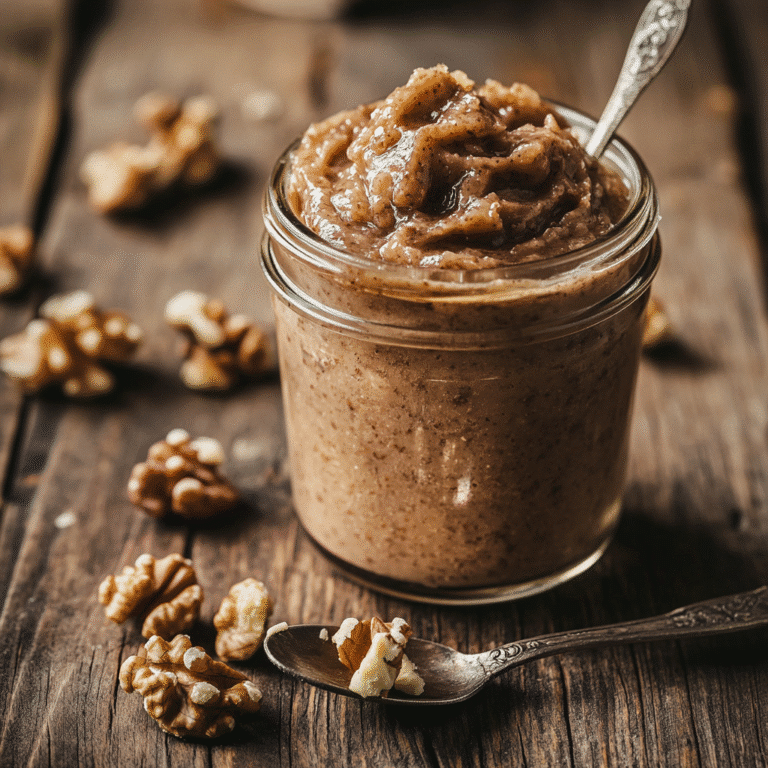Walnut butter is gaining serious attention in the health food world—and for good reason. As someone deeply passionate about nourishing, flavorful creations that fit real lifestyles, I’m always looking for ingredients that check all the boxes: delicious, wholesome, and versatile. Whether you’re a foodie, a wellness seeker, or just bored with peanut butter, this rich, nutty spread might become your next kitchen staple.
In this guide, we’ll explore everything from how walnut butter compares nutritionally to peanut butter, how it tastes, the best ways to use it, and just how much you should be enjoying daily.
Don’t miss our Pistachio Nut Butter guide if you’re diving deep into gourmet nut butters.
Table of Contents
What Is Walnut Butter and Why Everyone’s Talking About It
Nutritional Breakdown of Walnut Butter
Walnut butter is made from finely ground walnuts, sometimes roasted, sometimes raw, and blended until creamy. Unlike some other nut butters, it’s naturally rich in alpha-linolenic acid (ALA)—a plant-based omega-3 fatty acid that supports heart and brain health.
Here’s a quick snapshot of the nutritional value in 1 tablespoon (16g) of pure walnut butter:
| Nutrient | Amount |
|---|---|
| Calories | 183 |
| Protein | 4g |
| Total Fat | 18g |
| Saturated Fat | 1.5g |
| Omega-3 (ALA) | ~2.5g |
| Carbohydrates | 3.9g |
| Fiber | 1.4g |
What stands out most is the omega-3 content, which is significantly higher than that found in peanut butter. This makes walnut butter a powerful food for reducing inflammation, supporting mental clarity, and promoting overall wellness.
Unlike processed spreads, walnut butter can be kept clean—just nuts, maybe a pinch of salt, and no added sugar or oils. When shopping, always check labels or try making your own in a high-speed blender or food processor.
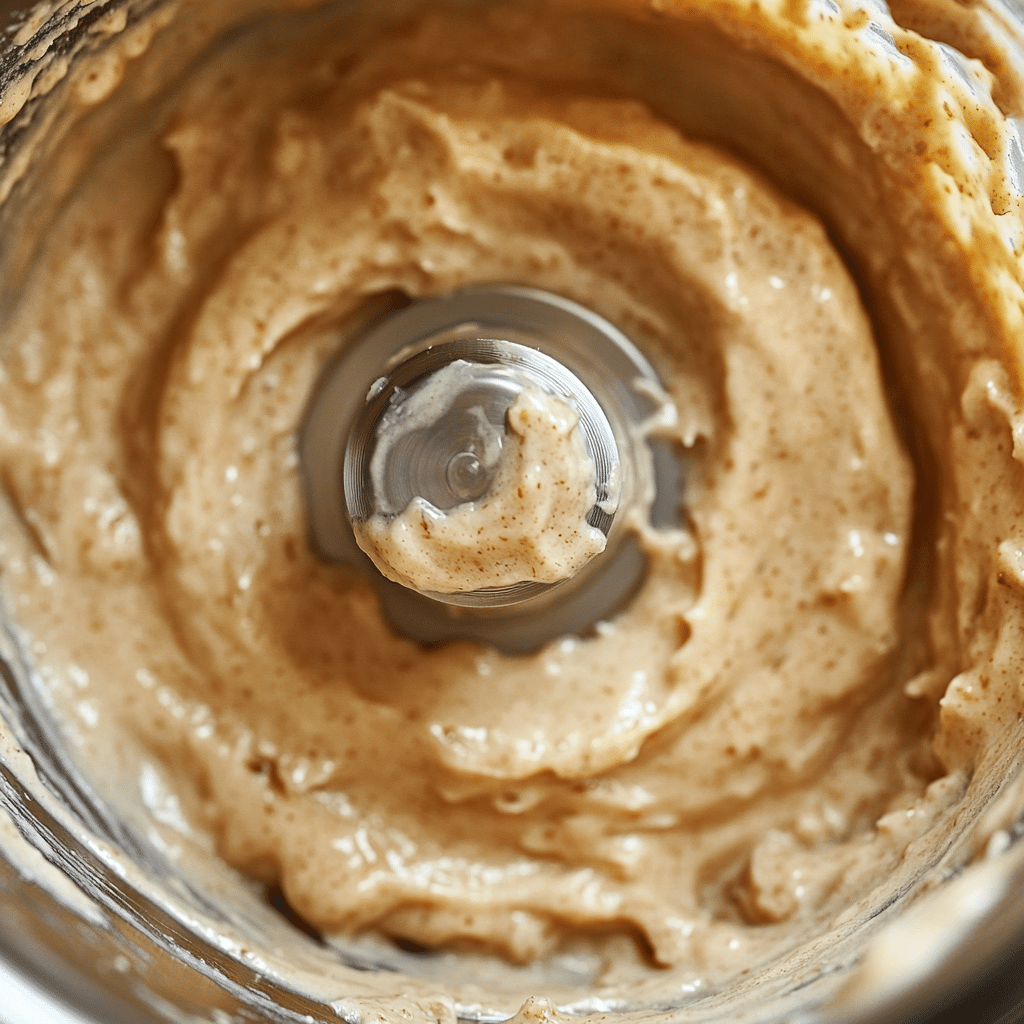
How Walnut Butter Is Made and Its Rise in Popularity
Walnut butter hasn’t always been mainstream. Peanut butter still dominates store shelves, but wellness trends are shifting that narrative. As more people explore plant-based fats and cleaner eating, walnut butter is gaining traction.
It’s easy to make at home: simply roast raw walnuts (or not), then blend until creamy. Some people add cinnamon, vanilla, or sea salt to enhance flavor. Homemade walnut butter tends to separate due to its natural oil content—just stir and store in a cool pantry or fridge.
Food bloggers, health coaches, and recipe creators (like me!) are incorporating walnut butter into smoothies, desserts, sauces, and even salad dressings. And with its creamy texture and earthy richness, it feels indulgent—without the guilt.
Don’t miss our Pistachio Butter recipe for another silky nut-based spread worth trying.
Print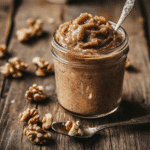
Walnut Butter: The Creamy Superfood Spread Your Pantry Needs
- Total Time: 20 minutes
- Yield: 1 cup
- Diet: Vegan
Description
Walnut butter is the next-level spread foodies and wellness lovers are raving about. Rich in omega-3s, earthy in taste, and incredibly versatile—it’s the perfect upgrade to your nut butter game.
Ingredients
- 2 cups raw or toasted walnuts
- Optional: 1/4 tsp sea salt
- Optional: 1/2 tsp cinnamon or vanilla extract
Instructions
- Preheat oven to 350°F (if toasting). Spread walnuts on a baking sheet and toast for 8–10 minutes, stirring once.
- Let walnuts cool slightly, then transfer to a food processor or high-speed blender.
- Blend until creamy, scraping down sides as needed. This may take 5–10 minutes.
- Add salt, cinnamon, or vanilla if desired, and blend again to combine.
- Store in an airtight jar in the fridge or cool pantry. Stir if natural oils separate.
Notes
Use toasted walnuts for a nuttier, less bitter flavor. Stir before each use if natural oil separation occurs. Pairs well with fruit, oats, and baked goods.
- Prep Time: 10 minutes
- Cook Time: 10 minutes
- Category: Condiment
- Method: Blended
- Cuisine: Health Food
Is Walnut Butter Healthier Than Peanut Butter?
Omega-3s, Antioxidants, and Anti-Inflammatory Benefits
When it comes to choosing a healthier nut-based spread, many health-conscious eaters are turning to walnut-based options as a nutrient-packed alternative to traditional peanut spreads. One of the standout benefits is its high concentration of ALA (alpha-linolenic acid)—a plant-sourced omega-3 fatty acid known for promoting heart and brain health.
Unlike peanut-based spreads, which are rich in monounsaturated fats, walnut options deliver potent anti-inflammatory properties and more polyphenols—powerful antioxidants that help combat oxidative stress and support long-term wellness.
Here’s a breakdown of how the two stack up nutritionally:
| Nutrient | Walnut-Based Spread | Classic Peanut Spread |
|---|---|---|
| Omega-3s (ALA) | ~2.5g | ~0g |
| Protein | 4g | 7g |
| Saturated Fat | 1.5g | 3.3g |
| Sugar | 0g (unsweetened) | 1–2g |
| Antioxidants | High | Moderate |
In short, while peanut butter delivers more protein, walnut versions offer a healthier fat profile and more protective antioxidants.
Comparing Calories, Protein, and Fat Content
Both spreads come in at about 180 to 200 calories per tablespoon, with most of the energy coming from fat. But not all fats are created equal. The oils in walnuts contain a more balanced mix of essential fatty acids, while peanuts are primarily monounsaturated.
In terms of protein, peanuts do have the upper hand, making them a go-to for post-workout snacks. But if you’re after anti-inflammatory effects and brain-friendly nutrients, walnut-style spreads can easily be part of your daily lineup—especially when paired with high-protein foods like chia pudding, yogurt, or cottage cheese.
Also worth noting: store-bought peanut varieties often contain added sugar, hydrogenated oils, or preservatives. Walnut spreads, particularly homemade or minimally processed brands, are usually simpler and cleaner.
Don’t miss our Glow Tea recipe—it pairs beautifully with any nut-based spread and supports overall inflammation reduction.
What Does Walnut Butter Taste Like?
Flavor Profile: Earthy, Rich, and Slightly Bitter
If you’re new to this spread, the first spoonful might surprise you. Compared to more familiar nut options, this one has a distinctly earthy and bold flavor. The taste leans slightly bitter, with rich undertones that reflect the depth of whole walnuts.
That bitterness comes from natural compounds in the skin of the nut, which are full of antioxidants. But don’t worry—it’s not overpowering. The texture is smooth and creamy, with a slightly dry finish that makes it unique compared to the silkiness of peanut or cashew spreads.
Think of it as more gourmet, less sweet. This complexity is what makes it so popular in health-forward kitchens and artisan food circles. It adds sophistication to both sweet and savory dishes without overpowering them.
If you’re someone who enjoys the taste of dark chocolate, coffee, or even tahini, you’ll likely appreciate the flavor depth of this spread.
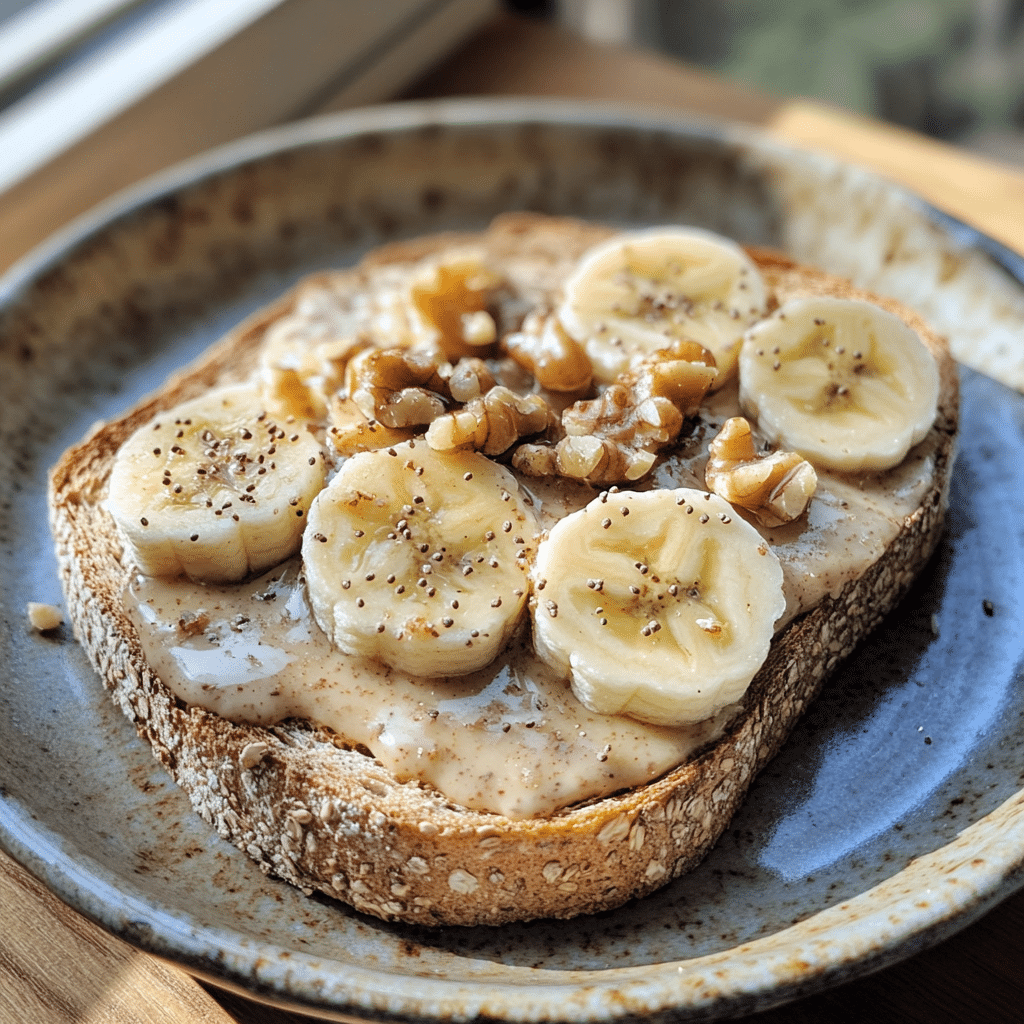
Toasting vs. Raw Walnuts: How Processing Changes the Taste
The flavor also depends heavily on whether the walnuts used were raw or toasted.
| Preparation Method | Flavor Impact |
|---|---|
| Raw Walnuts | Earthy, mildly bitter, with a slight tang |
| Toasted Walnuts | Rich, nutty, deeper caramelized notes |
Toasting the nuts before blending brings out their natural oils and sweetness, minimizing bitterness and enhancing spreadability. This makes a toasted version perfect for desserts, breakfast toast, or pairing with apples and bananas.
In contrast, raw walnut blends tend to taste more “pure” and slightly more intense—ideal for salad dressings or savory sauces where you want the walnut essence to shine.
Check out Cottage Cheese Banana Bread for a great pairing with both raw and toasted spreads.
Whether you prefer it raw or roasted, this nut-based alternative offers a flavor experience that’s rich, memorable, and far from ordinary. If peanut butter is comfort food, walnut spread is a conversation starter.
Best Ways to Use Walnut Butter in the Kitchen
Breakfast Ideas: Toast, Smoothies, Oatmeal
The morning is the perfect time to bring this rich, nutty spread into your routine. It pairs beautifully with both sweet and savory breakfast staples.
- On Toast: Slather a spoonful onto sourdough, multigrain, or seed bread. Add sliced bananas, a drizzle of honey, or a sprinkle of cinnamon for balance.
- In Smoothies: Blend into your green or berry smoothie to add creaminess, a protein boost, and healthy fats. It works especially well with almond milk, cacao, and frozen bananas.
- Stirred into Oatmeal: A tablespoon stirred into hot oats offers a buttery, earthy flavor and makes your breakfast more satisfying. Add chopped dates, berries, or a splash of vanilla extract.
Because of its naturally rich texture, just a spoonful can go a long way—and it adds a dose of omega-3s to your morning.
Sweet vs. Savory Dishes: Sauces, Dips, Baked Goods
Don’t limit this spread to breakfast—it shines all day long.
Savory ideas:
- Walnut butter dressing: Mix with lemon juice, garlic, and olive oil for a creamy salad dressing.
- Pasta sauce base: Combine with veggie broth, nutritional yeast, and herbs to create a dairy-free, umami-rich pasta sauce.
- Dip or spread: Use it in place of tahini for a Mediterranean-inspired dip, or spread it onto wraps with roasted veggies.
Sweet uses:
- Baked goods: Add it to cookies, muffins, or energy bites for extra flavor and moisture.
- Swirled into brownies: Its earthy flavor complements dark chocolate perfectly.
- Frosting substitute: Blend with maple syrup and a dash of vanilla to make a simple, dairy-free topping.
This spread’s versatility is what makes it such a pantry staple. It complements a wide variety of ingredients and can easily replace peanut or almond butter in most recipes.
Looking for inspiration? Try Tortilla Cinnamon Rolls for a warm, soft dessert that’s perfect with a walnut swirl.
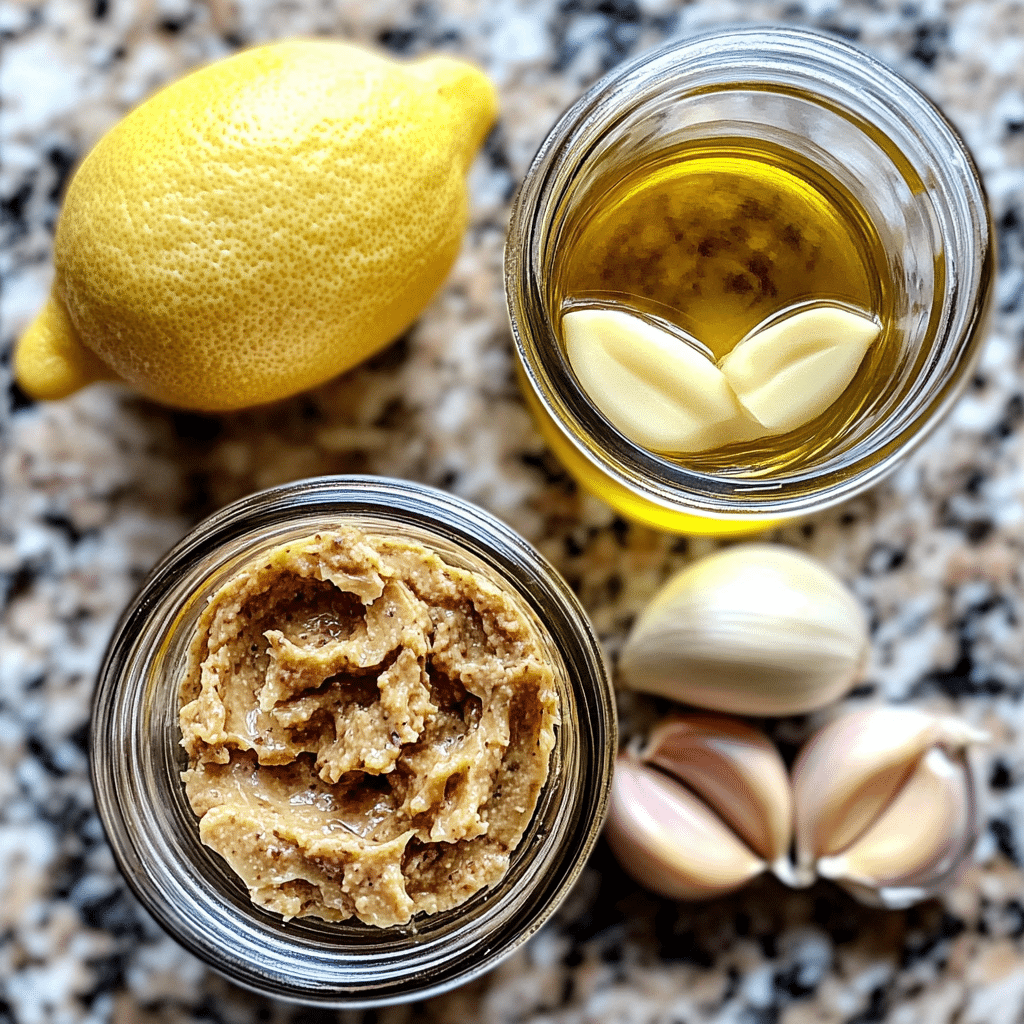
Whether you’re whipping up breakfast, baking from scratch, or meal prepping sauces for the week, incorporating this spread into your kitchen routine is both nourishing and exciting.
How Much Walnut Butter Should You Eat a Day?
Portion Guidelines from Nutritionists
As nutrient-rich as it is, moderation is still key when it comes to this spread. Nutritionists generally recommend 1 to 2 tablespoons per day as a healthy serving size for most adults. That’s enough to get the benefits—like healthy fats and antioxidants—without going overboard on calories.
Each tablespoon contains about 180–200 calories, most of which come from fat. But don’t let that scare you. These are heart-healthy fats, primarily polyunsaturated, including the beneficial omega-3s that support brain and cardiovascular function.
If you’re incorporating this spread into multiple meals—like in a smoothie and then later on toast—it’s important to track portions to avoid excess fat and calorie intake, especially if you’re also consuming other high-fat foods like avocado, olive oil, or seeds.
For kids, the portion recommendation may be smaller—around 1 teaspoon to 1 tablespoon per day, depending on age, activity level, and overall diet.
When Too Much of a Good Fat Becomes Bad
Even though the fats found in walnut-based spreads are beneficial, eating too much of any fat-rich food can disrupt a balanced diet. Overconsumption might:
- Lead to unwanted weight gain if not offset by physical activity
- Crowd out other important macronutrients like protein and complex carbs
- Trigger digestive discomfort in some individuals sensitive to high-fat foods
Plus, it’s easy to overeat because of its rich, creamy texture and slightly addictive flavor. A spoon here, a swipe there—it adds up. One smart tip is to pre-portion it into small containers or use measuring spoons when spreading or adding it to recipes.
When enjoyed mindfully and in appropriate portions, it becomes a powerful addition to a heart-healthy, plant-forward lifestyle.
Don’t miss our Scrambled Cookie for a creative dessert that can be enhanced with a walnut swirl—just a tablespoon gives your treat a nutritional upgrade.
Conclusion: Is Walnut Butter Worth It? Absolutely.
If you’re looking to switch up your nut butter game, walnut butter is a smart, satisfying, and nutrient-rich choice. From its earthy flavor to its incredible omega-3 content, it checks every box for foodies and health-focused eaters alike.
Whether you’re spreading it on toast, stirring it into oatmeal, baking it into cookies, or blending it into smoothies, it brings both flavor and function to the table. Just keep portion sizes in mind and opt for high-quality or homemade versions without unnecessary additives.
Follow us on Facebook for fresh new recipes, cooking tips, and food inspiration every week!
Walnut Butter FAQs and Quickfire Nutrition Insights
Is walnut butter healthier than peanut butter?
Yes—especially if you’re looking for a spread with more omega-3s and antioxidants. While peanut butter contains more protein, walnut-based spreads offer a better fatty acid profile with anti-inflammatory benefits. It’s a smart choice for heart and brain health, particularly if you’re cutting back on processed oils.
What does walnut butter taste like?
Expect a rich, earthy flavor with a slightly bitter undertone—especially if made with raw nuts. When toasted, the taste becomes warmer and nuttier, almost caramel-like. It’s less sweet than peanut or almond butter but packs a gourmet punch, making it perfect for both savory dishes and more refined desserts.
What can I use walnut butter for?
This spread is incredibly versatile. Use it:
On toast with fruit
In smoothies for healthy fat and flavor
Swirled into oatmeal or yogurt
As a base for dressings and sauces
Baked into cookies or energy bites
It’s also excellent in pairings—don’t miss our Tortilla Cinnamon Rolls as a warm, comforting treat that matches perfectly with a nutty topping.
How much walnut butter should I eat a day?
Stick to 1–2 tablespoons per day for adults to reap the nutritional benefits without overloading on calories. For children, 1 teaspoon to 1 tablespoon is generally enough, depending on their dietary needs. Portion control is key because, while healthy, it’s calorie-dense.

